Draft Strategies | Depth Charts | Mock Drafts | SOS | Tools | ADP
Diehards Staff Experts Poll | Draft Simulator | University Videos
Who’s There to Protect the Team, Offensive Line Rankings to Start the 2018 Season

A Crucial, Overlooked Component
The old adage goes that the game of football is won and lost in the trenches, and to this day the saying stands as dogma. Without sufficient protection, a quarterback cannot deliver an accurate pass to any kind of receiver. Profootballfocus (PFF) has found that the single most reliable statistic for projecting quarterback performance is accuracy in a clean pocket. Any metric of success found outside of that confine is inherently more chaotic, and thus, less reliable. Without decent blocking, chaos in introduced to the quarterback’s play, and that leads to decreased production. After quantifying the average loss to passer rating found on PFF’s website, applying pressure to a quarterback decreases their rating by 20.67 points. If one applied the numbers, on average that’s enough to turn Tom Brady into Blake Bortles.
Furthermore, without decent run-blocking, even the best backs will be stifled. In both gap and zone blocking styles, if an offensive line can’t create lanes for an RB to work with defensive penetration will stop any forward momentum before it can even get going. This is the reason why metrics like yards before and after contact are measured. An elite tier running back will average five yards a carry (Y/C) or more, but if his offensive line fails to produce for him, a Y/C average could drop as much as two to three points.
Last year, my strength of schedule determined that the Jets had the easiest rushing schedule in the league, while the Broncos had the easiest passing schedule. Along with that, it found that the Rams and the Steelers had the 31st and 30th most difficult schedules respectively. The differences between the two teams came down to talent, scheme, and most importantly here, offensive line production. According to my weighted model for offensive line production, the Steelers had a top half run-blocking line, along with the best pass-blocking line, while the Rams had a top half pass-blocking line, and the second-best run-blocking line last year. On the other hand, in 2017 the Jets had the worst run-blocking offensive line, and the Broncos were bottom ten in production in both pass and run blocking (the prospects do look better for the Broncos this year with the addition of Jared Veldheer at right tackle, and the movement of Ron Leary back to his natural position of left guard). This goes to show how influential t
he constant variables of blocking play in the game. When I introduced offensive-line productivity into my model, eight of the top ten ranked teams had a second half of the season RB1.
If one wants to compete at the highest level of fantasy, the offensive line must be a point of emphasis.
Offensive Line Rankings
In lieu of grades or rankings, this article will focus on depictions of the raw data. Tying each team to a letter grade or rank removes an enormous amount of context from the expected performance of each line. As one can see from the chart below, although Philadelphia, Atlanta, and New England would likely each receive an A, or a top 3 ranking, that wouldn’t speak to the substantial gulf between the Eagles and the rest of the pack.
More context on the grades would be helpful to understand them. These grades are made based on the previous year’s production, off-season additions and departures, profootballfocus data, and a personal weighted system. This weighting system is crucial because it adjusts scores based on the outsized impact that phenomenal and putrid players have on the game in a production and leadership sense. Positive grades depict good expected outcomes while negative grades depict poor coming production.
Below are each of the graphs, the numbers in the graphs are normalized figures based on the outcome of the model, while the numbers provided in the second group of figures are the final numbers that each graph is based on.
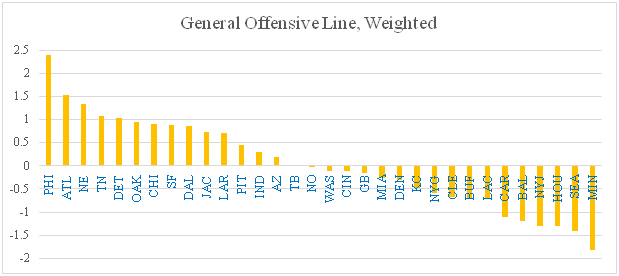
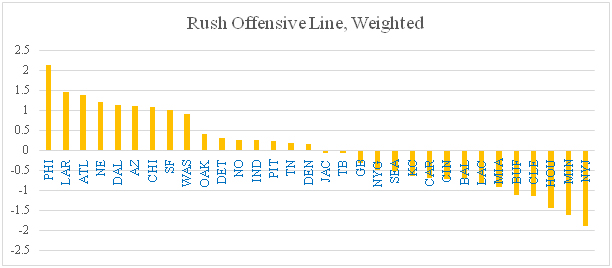
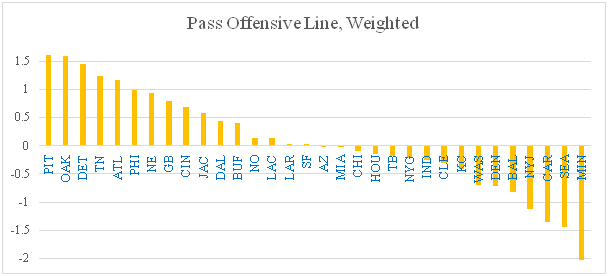

Best Offensive Lines
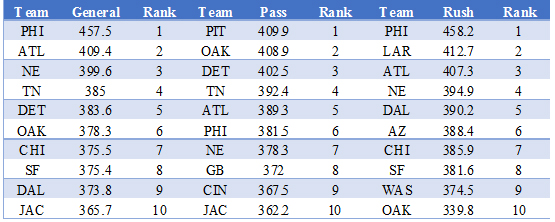
Worst Offensive Lines
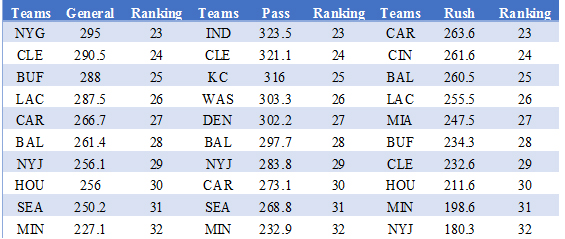
Critical Observations
Injuries and departures can ruin a line
• Panthers
Last year, the Panthers had one of the best offensive lines in football; but after the departure of Andrew Norwell to the Jaguars, followed by injures to his replacement, Amini Silatolu, and all-pro right tackle, Daryl Williams. Their line has fallen to the bottom of the league. Cam Newton is going to have to run more and will not be able to develop any kind of play-action or deep passing game since it is more than likely he will face consistent pressure in the pocket in less than two second. Though this could be a boon to Christian McCaffery as he’s likely to see even more dump-off passes as Cam will likely face pressure immediately.
• Vikings
With the surprise death of offensive line coach Tony Sparano, along with the injuries of Nick Easton, and Mike Remmers the Viking’s offensive line has gone from bad to worse. According to the model The Vikings are the worst overall offensive line going into the 2018 season. The Vikings played better than expected in 2017, but that had much to do with Case Keenum having one of the two best production rates while being under pressure, and Tony Sparano’s outsized impact. Without Sparano and veteran leadership on the line, it is possible that the Viking’s offense fails to live up to its potential in 2018.
Neglect rears its head
• Texans
After losing Duane Brown to the Seahawks last year, the Texans have no players that earned an average grade in 2017. Without significant draft or free agent investments into the line, it is likely that just like with the Vikings, the Texans may have a tough time cashing in on their easy strength of schedule. People who fear for Deshaun Watson’s health have cause for concern behind this offensive line.
• Seahawks
The Seahawks are similar to the Texans in that they have no above average players, expect for Duane Brown who they were able to acquire from the Texans. Russell Wilson has been a paragon of health since entering the league, but he needs protection to play his best football. With the departures of Paul Richardson, and Jimmy Graham, along with a rookie first round pick at running back, the Seahawks will find themselves challenged to produce as many have come to expect.
Surprise Strengths
• Lions
After a year of injuries, the offensive line in Detroit looks ready to break out. After spending a noticeable portion of their cap space on Ricky Wagner and Paul Worrilow, the Lions were rewarded with above average production from both players. With the return of Taylor Decker, the Lions are likely to have a top-five offensive line in production across the board. Second round pick Kerryon Johnson was traded up for this year, and this offensive line looks to help him be the first successful Lions rusher since Reggie Bush in 2013.
• 49ers
Since the departures of Anthony Davis, and Mike Iupati in 2014 the 49ers offensive line has been a mess. In 2016, 49ers quarterbacks were sacked at the third highest rate in the league. The line took a huge step forward in 2017 and jumped to 22nd in this metric. With the addition of Weston Richburg, and PFF’s top rated rookie offensive tackle, Mike McGlinchey the 49ers offensive line looks to be a top-ten unit in 2018. This makes sense as offensive line production has always been a priority for Kyle Shanahan. Every year that Shanahan has been an offensive coordinator or head coach, he has generated an RB1, and this has nearly as much to do with his devotion to the offensive line as his brilliant schemes. With that in mind, Jerick McKinnon stands to be a steal at the end of the third round in most leagues.
• Jaguars
If second-year left tackle Cam Robinson can develop into a serviceable starter, the Jaguars have a chance to be a dominant force in the trenches. After picking up first-team all-pro guard, Andrew Norwell the Jaguars have a pair of guards that didn’t allow a sack in 2017. When healthy Brandon Linder is one of the best centers in the league, as he earned the highest single game grade by an offensive lineman in 2017 according to PFF. The Jaguars are in the rare situation (along with the Eagles) that have one of the easiest schedules in the NFL, along with one of the best offensive lines. Everyone on this team is a value at this point as even Leonard Fournette is often seen drafted at the beginning of the second round in twelve-team PPR leagues.
Factor Everything In
When used in concert with the strength of schedule articles published earlier this week on footballdiehards.com, the path to breakouts are laid down. Don’t be afraid to be buck trends if all the data points to success.
O-Line Rankings
| Ranking | Team | Total |
|---|---|---|
| 1 | PHI | 432 |
| 2 | ATL | 402 |
| 3 | NE | 391 |
| 4 | OAK | 376 |
| 5 | DAL | 373 |
| 6 | DET | 373 |
| 7 | LAR | 372 |
| 8 | TN | 367 |
| 9 | SF | 364 |
| 10 | CHI | 364 |
| 11 | PIT | 363 |
| 12 | AZ | 353 |
| 13 | JAC | 345 |
| 14 | WAS | 333 |
| 15 | NO | 333 |
| 16 | IND | 331 |
| 17 | GB | 326 |
| 18 | TB | 320 |
| 19 | CIN | 317 |
| 20 | DEN | 311 |
| 21 | NYG | 299 |
| 22 | MIA | 298 |
| 23 | LAC | 295 |
| 24 | KC | 295 |
| 25 | BUF | 292 |
| 26 | CLE | 281 |
| 27 | BAL | 273 |
| 28 | CAR | 268 |
| 29 | HOU | 266 |
| 30 | SEA | 265 |
| 31 | NYJ | 240 |
| 32 | MIN | 220 |
